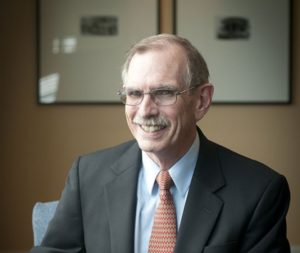Categories
Rod Collins: Innovation Discovery and How to Do It the Right Way
Richard Kasperowki interviews Rod Collins. Rod is the director of innovation at Optimity Advisors and innovation curator at Salt Flats. Rod and I talk about the collectivization of strategic leadership in the dynamic business environment of the 21st century. In the world of rapid innovation, we need all intellectual firepower we can get to discover things we had no clue existed! And that is where collective intelligence, or as Rod calls it, Wiki Management, kicks in. Connect with Rod on Twitter at https://twitter.com/collinsrod and visit his page at https://optimityadvisors.com/about/leadership/rod-collins .
Rod Collins: Innovation Discovery and How to Do It the Right Way
with Rod Collins


TRANSCRIPT
Richard Kasperowski: (00:08)
Hi, friends. Welcome back to With Great People, the podcast for high performance teams. I’m Richard Kasperowski. In this episode I talk with Rod Collins, Director of Innovation at Optimity Advisors and Innovation Curator at Salt Flats. Rod is the author of an amazing book on a revolutionary management model that he calls Wiki Management. We talk about the importance of innovation discovery, the real meaning of collaboration, and the shift toward collective intelligence and group leadership in the rapidly changing business climate of the 21st century. I hope you enjoy it.
Richard: (00:44)
To support this podcast, visit my website, kasperowski.com. Thanks for listening.
Richard: (00:51)
All right, we’re here at Agile New England and I’m with our headline speaker tonight. His name is Rod Collins. Rod, I’m about to introduce you to the audience here at Agile New England. When I do that, what should I say?
Rod: (01:05)
Well, I have a dual role. I serve as the director of innovation for a consulting firm known as Optimity Advisors and they’re in the business of innovation and strategic consulting.
Rod: (01:17)
I also serve as the innovation curator at Salt Flats. Salt Flats is an innovation house and innovative approach, especially to business strategy and business innovation. Its main focus is to connect people with an ecosystem, because you just can’t accomplish what you need to do within your four walls.
Rod: (01:37)
Both of these organizations are focused on a very different approach to strategy. In the past, the foundation of strategy has been strategic planning. So, in the 20th century, if you wanted to scope out the future, what you did was look backwards. You understood all the relationships, your business metrics, your product metrics, your market metrics. And then you could forecast them out. Because back in those days, the past was a proxy for the future.
Rod: (02:07)
Well today, the world is rapidly changing and planning can become a strategic trap. It’s no longer the foundation of strategy. Planning is merely a tactical activity. It’s still important, but a tactical delivery.
Rod: (02:20)
The basis of strategy in a rapidly changing world is discovery. The difference is, if you’re focused on strategic planning and when you do consulting in that standpoint, oftentimes your business problems are in this space of, “What I know, I don’t know.” That’s when you would hire in experts and consultants.
Rod: (02:39)
We think the work of consulting has changed, and that the fundamental problems today are in the area of what you don’t know that you don’t know. That’s why discovery is the new foundation of strategy and requires very, very different business competencies.
Richard: (02:54)
All right. You called yourself an innovation curator. I love that term. What does that mean, an innovation curator?
Rod: (03:02)
Well, when you are essentially in the space of what you don’t know that you don’t know, what leadership often is about is leading discovery processes. So, leadership isn’t about taking charge anymore. Because when the world is known, the past is a proxy for the future, you can lay out a course. Single leader can do that and then we’re just going to control and make sure we do what we plan to do.
Rod: (03:26)
When leadership is about curation, then what you need to do is lead groups through discovery processes. And oftentimes you’re tapping into the collective intelligence of the many rather than the individual intelligence of the few, because it turns out collective intelligence winds up being a fairly reliable window into the future. No one person can see it, but when you have processes that are able to call into the collective intelligence across experts, non-experts, and what I like to call unusual suspects, it’s often powerful in terms of getting businesses to ask the right questions, so that they can find the new answers and discover what it is they don’t know that they don’t know.
Richard: (04:13)
All right. So leading people through innovation discovery is sort of creating the environment for it, in which it can take place. And this idea of collective intelligence, I love that idea.
Rod: (04:23)
Yeah.
Richard: (04:24)
It’s a lot of what this podcast is about, collective intelligence, best teams. Part of what we do on this podcast is, I always ask people to share, what is the best team that you’ve been on in your life? Is there a team like that for you?
Rod: (04:39)
Actually, two teams.
Richard: (04:40)
Two? Two bests.
Rod: (04:41)
All right. I’m going to start out with one. In a former life, I was the chief executive of the Blue Cross Blue Shield Federal Employee Program. It’s a rather large enterprise. When I left in 2007, it was $19 billion in revenue per year. It was a business alliance of all the Blue Cross and Blue Shield organizations and there were about 60 operating units at the time. All these units were independent entities.
Rod: (05:09)
So, we weren’t leading a top-down organization. We were leading a network. Okay? And we had had some performance challenges that involve … Our customers weren’t as happy as they could have been and these various organizations weren’t as happy with the general leadership as we would have liked.
Rod: (05:28)
So, figuring out what we had to do, our first observation was, “We are a network,” and part of our problem was we were leading this network like it was a hierarchy. So we had a lot of arguments over who’s in charge. Well, we’d say, “Well, suppose we forget about that and find different ways in which we can bring these organizations together.”
Rod: (05:48)
So, as part of this approach, I had instituted a new role that was called the account executive, which would be a single point of contact for each of these 60 organizations. I had 70 people who would cover them.
Richard: (06:01)
Wow.
Rod: (06:02)
I’m sorry, seven people who would cover them.
Richard: (06:05)
Seven people.
Rod: (06:06)
Seven people. Each of them would have about nine or 10 organizations apiece. Okay? I set them up as a self-organized team and I led them very, very loosely. I wanted them to become a strong team and to help each other, and they helped us turn this around. Our satisfaction with the Blue Cross Blue Shield organizations went from about 70% rating us four or above on a five-point scale to 97% ratings.
Rod: (06:37)
They really saw us as better leaders once we were giving them the attention they needed. Single points of contact would be able to handle any issue that came up between this entity and the central staff.
Rod: (06:51)
This team itself was incredibly powerful. I can remember being in meetings with them at times, where they would laugh and say, “If anybody walked in here, they’d never know that you were the boss.” I felt good about that.
Rod: (07:06)
I’ll always remember one thing that stood out for me, is one of the seven had to go on short-term disability and I thought, “Boy, we got to get somebody. We have to get her nine or 10 organizations covered.” So, I called a meeting to do that. When I walked in the meeting, they said, “Oh, we’ve already taken care of it. We distributed all of them.” I just smiled and says, “I love when 60-minute meetings are done in five.”
Rod: (07:31)
But I really walked out of there really feeling a sense of pride, that this team had really, really jelled. They were very different personalities, but as a group, they really jelled and developed a real sense of identity, and exercised a group leadership that I think was critical to the improvements that we had within the business.
Rod: (07:53)
The other team I worked with is, when I became the business’s chief executive in 2002, was the senior leadership team.
Richard: (08:02)
Uh-huh (affirmative).
Rod: (08:03)
It was a highly effective team because of a particular practice that we put in place, which I saw as something also that Alan Mullaly did within Ford, when he turned Ford around. The practice was this. And when I tell most organizations about this, their eyes get as big as buckets because they say, “Oh, we’d never have the time to do that.”
Richard: (08:29)
The way you’re leading up to this, “What is it? What is it? What is it? I want to know.”
Rod: (08:34)
Once every two weeks we would go off-site and have an all-day strategy session.
Richard: (08:39)
No kidding?
Rod: (08:39)
Not once a year, once every two weeks. The amazing thing is, most leadership teams, especially senior leadership teams, don’t spend sufficient time on business strategy.
Richard: (08:53)
Yeah or sufficient time together.
Rod: (08:56)
When your challenge in the business environment is discovering that you don’t know what you don’t know, you can’t afford to be meeting once a year-
Richard: (09:06)
Oh, my God. No.
Rod: (09:07)
… for this business strategy. When the past is a proxy for the future and tomorrow’s going to look like today, well then once a year gets it done. Put together a plan. The plan is an annual plan.
Rod: (09:18)
Strategy’s not about planning anymore. It’s about discovery. The discovery never ends. So, what we realized was important is, we needed a strategic dialogue once every two weeks. We would have no more than three or four strategic points of focus. We would spend time really deeply digging into the business.
Rod: (09:41)
I think that deep work in strategies is the greatest gift that senior leadership teams can give to their staffs because only they can do it. This team that I worked with was highly effective. Over the five years that I was the program’s chief executive, from 2002 to 2007, it remains to this day the single largest five-year growth period in the 60-year history of this business.
Richard: (10:08)
Wow.
Rod: (10:09)
And I attribute it to this team. It was highly effective. It was a high degree of collaboration. And when you spend that type of quality time, that’s what happens.
Richard: (10:20)
Yeah.
Rod: (10:21)
As I mentioned, this is a similar thing that Alan Mulally did at Ford. Somebody wrote a book about Ford’s turnaround. I forget the name of the book. But what stood out for me is, when Mullaly was hired, the board told him, “Feel free to let go of any senior staff member that you think you need to. Because we got to get Ford turned around.” They were losing about $16 billion a year.
Rod: (10:48)
He kept telling them, “I don’t think I’m going to have to do that.” Because what he intended to do was to bring in a discipline that he used at Boeing. And that discipline, he called it … I believe he called it the business process. I mean, it was a real vanilla term, business process meeting or something.
Richard: (11:05)
The business process.
Rod: (11:08)
But at any rate, what he did was, every Thursday get all of his strategic leaders together, and to get them to color code where they were and to get them to be helping each other. Instead of being fiefdoms, keeping problems to themselves because, “I’ll look bad,” he got them to know, “If we’re going to be good, we’ve got to share problems and we have to help each other. We’ve got to be looking at this and again, spending quality time together.” I just cannot overemphasize the importance of strategic leadership teams spending time together.
Rod: (11:44)
My anecdotal observation, when I make this to a lot of people, they smile and go, “Oh my goodness, you’re right.” I think, in the typical organization, that it’s highly likely that the most dysfunctional team is its strategic leadership team. And it needs to be the most functional team in the business.
Richard: (12:02)
Yeah and a model for everybody else.
Rod: (12:03)
In a rapidly changing world, senior leaders have to spend time together. It’s the only way that they can effectively process what’s happening in the world at that time.
Richard: (12:14)
Yeah. All right. This is awesome. I want to pick one of these two teams and go deeper.
Rod: (12:18)
Okay.
Richard: (12:19)
Do you want to do the executives … or the senior leadership team or the account executives?
Rod: (12:23)
Let’s go with the senior leadership team.
Richard: (12:24)
Okay. So more about this team. If you could condense everything about this team and summarize it in one word, do you have a one word that we could use?
Rod: (12:35)
Yeah. Yeah. Collaboration.
Richard: (12:36)
Collaboration?
Rod: (12:37)
Yeah, it was a highly collaborative team. And the thing about collaboration is, when it is a reality and not a theme, you don’t have a lot of the interpersonal issues that tend to happen. So, one of the benefits of going off-site for a whole day every two weeks is, there was a lot less turf fighting.
Rod: (13:02)
So, the time that you spend or invest in doing this pays itself back multiple times. How much of the CEO’s work is spent bridging gaps between the various units because they’re not getting along?
Richard: (13:18)
Yeah, that’s a waste.
Rod: (13:19)
That’s wasted time. Okay? So while it may appear, my goodness, one out of every 10 days off-site, that pays itself back many times. And oftentimes what happens is, these senior leaders are able to effectively handle issues among themselves without having to bring in the CEO.
Richard: (13:42)
It’s like they became friends versus enemies. By default, they’re set up to be enemies. They have their own turf that they’re protecting.
Rod: (13:50)
There’s esprit de corps and there’s a history that gets created. And then it becomes a behavioral experience of, “Well, we continually work things out together because that’s just the way the air works around here.”
Richard: (14:05)
Yeah.
Rod: (14:05)
One thing I’d like to interject into this … Because I think that there is a fundamental transition … or transformation’s probably a better word … happening in the realm of leadership. If you look at all the leadership training that we’ve had over the past three, four, five decades, the focus of it is all on individual leaders.
Rod: (14:31)
I would venture that, when you really look closely at it, what most leadership programs are about is how to treat … how to train rather, strategic leaders to hold their hierarchical authoritative power in such a way that it is beneficial. That they are benevolent leaders, that they share their power, but it sees leadership as fundamentally residing within the individual.
Richard: (15:00)
Uh-huh (affirmative).
Rod: (15:01)
I think going forward, that part of the transformation of 21st century business is the unit of leadership is no longer the individual, it’s the team. I think leadership training, as a consequence, needs to happen in the context of full teams. Because you can train an individual to be a better leader when strategy’s about planning, when the past is a proxy for the future and when you can leverage the individual intelligence of a single person to make the organization smarter.
Rod: (15:36)
But when the basis of strategy is discovery, when your fundamental issues are discovering what you don’t know that you don’t know, leadership becomes a team. It’s essentially a team phenomenon.
Rod: (15:50)
I think this is what Mulally understood. That he had to build a highly effective team. It wasn’t about him. It was about the team he built. It’s also why I think he says, “I’m not looking to fire individuals. The problem is not the individuals. The problem is we don’t have a highly effective team. That’s what I’m going to build. That’s what leadership is about.”
Richard: (16:20)
All right. I love this. This is totally congruent with with other guests we’ve had on this podcast and with a lot of the work that I do. Okay. This leadership team, what other subjective sensations or observations could we make about it?
Rod: (16:36)
An interesting subjective observation, I’ve mentioned this to people over the years. I don’t know if it was by design. Probably not, because it’s probably by coincidence. This leadership team had no dominant gender.
Richard: (16:48)
No dominant gender. So they were-
Rod: (16:51)
We were half male, half female.
Richard: (16:53)
Interesting.
Rod: (16:54)
And as I reflect back upon the group, and it was highly effective, because there was no dominant gender, I think we wound up with an integration of the differing skills that I think the different gender perspectives bring to the table.
Rod: (17:11)
I think it’s important to recognize, we are all the same, we are all different. And I think as we value equality we also have to value differences.
Richard: (17:21)
Yeah.
Rod: (17:22)
I saw various different strengths between both the male and the female participants in the leadership team. I noticed that women were interested in making sure we thoroughly understood an issue. And understanding is extremely important, especially when your business context is discovering what we don’t know that we don’t know.
Richard: (17:48)
Sure.
Rod: (17:50)
I think that the male members of our team learn the importance of understanding, as their female colleagues kept pressing, “Let’s look at this. Let’s get behind this. Do we understand this dimension?” I think what I saw the men in the team do is, when reached the point of the understanding, they would come in and say, “All right, it’s time for us to land the plane.” Okay?
Rod: (18:17)
You’ve got to be able to do both things. You’ve got to fully understand an issue and at some point you have to land the plane. And I think what I saw over time was, that there was a real valuing of these different perspectives. And then I would see a cross-pollination of these skills. To what extent these are cultural, biological, I don’t know, but that was how the behavior played out. And I think that there was a high degree of respect across all members of the team. But I always reflect, I think it was an asset that this team did not have a dominant gender.
Richard: (19:02)
Yeah. that is so interesting and it corresponds to a lot of the research on teams. That teams that are more diverse … When we’re talking about creative problem solving or discovering information, teams that are more diverse get better results than teams that are less diverse, monoculture teams.
Richard: (19:23)
One thing about this leadership team that you said was that, while they were together, you had the single largest five-year growth period in the history of this organization.
Rod: (19:34)
That’s correct.
Richard: (19:35)
What other objective metrics do you have of the goodness of this team?
Rod: (19:42)
This is an important point. Because metrics are extremely important in a rapidly changing world and I think most businesses focus on the wrong numbers. They focus on the financial statement, which is what drives the quarterly short-term focus. They are looking at earnings per share, they’re looking at profit and loss, they’re looking at stock price.
Richard: (20:07)
These are things that are more like outcomes or results verus things that you control doing the work.
Rod: (20:13)
That’s right. You got it. Now, I’m not saying those numbers aren’t important. I think they are, and I think you do go to those numbers to measure performance. I think you hold executives accountable for results. But they’re lousy management tools. Because the purpose of management is, “Do everything I can to optimize the highest results of the organization.” If you’re managing to the financials, you find out you have problems when it’s too late.
Richard: (20:38)
Right. They’re lagging metrics.
Rod: (20:40)
What you need to do is come up with driver measures or leading indicators. So, one of the exercises we did in particular team was to come up with the four most important leading indicators of business. And in doing this, one of the numbers was a number that we invented. This is why this is a hard exercise. Because when you sit down with leadership teams, you can do the outcome performance measures just like that. You can get that done five, 10 minutes. But ask a group, “What are the most important leading indicators?” They are not necessarily intuitively obvious and they take some …
Rod: (21:19)
This is where you want to tap into the collective intelligence of the group. You may even extend beyond the group, to discover, what are the early warning indicators? When we did this, we identified four. And one of the things we did with this discipline, this wasn’t just something for the senior leadership team. We would measure those, generally on a quarterly basis, was what made sense our case for the leading indicators.
Rod: (21:49)
And then we would plaster them all over the wall, with color-coding. Okay? Because my feeling is, if you’re leading a network, then every individual should be able to know, without having to ask their supervisor, whether we’re winning or we’re losing.
Rod: (22:07)
Because we are working in the context of knowledge workers, they’re smart people. So, if they know what the indicators are and if they see one of them is slipping, without being organized, they will figure out a way.
Rod: (22:23)
You want to drive a level of self-organization. So anybody who walked off the elevator, on any of our floors, knew how leading indicators were doing because we had them plastered everywhere. I think that that drove a discipline, that I would call analogous to the simple rules of complex adaptive systems.
Rod: (22:46)
So most of the times, our figures were good. But if they were to split, we could do two things. One, people could begin directly, on their own, self-organizing about what needs to be done. That’s great. And then the second thing is, we could have discussions among the senior leadership team before a crisis had formed.
Rod: (23:09)
Because one of the things that’s different about the business environment today, as compared to the 20th century, when things went off the rails in the 20th century, the action you needed to take was one action. It’s corrective action. Okay? Things aren’t going according to plan, get it back on plan. That’s what we need to do.
Rod: (23:32)
In a rapidly changing world, you have to make a choice between two types of actions, and they’re critical. Because if you make the wrong choice, your business could be in serious trouble. What you have ask yourself is, if you see an indicator going negative, is it because we’re doing something wrong or is it because customer values are shifting?
Richard: (23:56)
Yeah. Has the environment changed?
Rod: (23:57)
If customer values are shifting, you need to be involved in adaptive action, not corrective action. If you get involved in corrective action when you should be adapting, you’re going to get deeper in trouble. So, you want to have that discussion before the crisis hits. Because if you need to be doing adaptive action, then you want to be doing your adapting, so you never have the crisis.
Rod: (24:23)
Now, think about it. Kodak had terrific metrics about what they measured, terrific measures for film. They were in the business of film. So, if they saw their film sales dropping, my guess is, and it is a guess-
Richard: (24:43)
Try to take corrective action on film sales.
Rod: (24:43)
I don’t have inside knowledge, but I bet that they were trying to correct and improve their … What they needed to do was adapt.
Richard: (24:47)
Oh, okay. So, you know what? Do you know the building we’re in right now is the Polaroid building?
Rod: (24:53)
All right.
Richard: (24:55)
Right? So they had a headquarters in Cambridge. We’re in Waltham, Massachusetts right now. This is the suburban Polaroid headquarters building. The name Polaroid has not been on this building in decades.
Rod: (25:04)
Yeah.
Richard: (25:05)
They were doing exactly what you’re describing here.
Rod: (25:08)
Yeah, and this is critical. This is why strategic discovery is important. In the 20th century, a sustainable competitive advantage meant I come up with an incredible product model. Okay? I get financially excellent and I get operationally excellent and I hold off everybody for about 40 years, because that’s how long a business model could last in the 20th century.
Rod: (25:32)
Today, sustainable competitive advantage is not about preserving the status quo. You can’t do that in a rapidly changing world. The only sustainable competitive advantage is for a company to have the ability to evolve itself from generation to generation of business and product models.
Rod: (25:50)
If Kodak had had that ability, they would be dominating photography in a digital world. And they should have, because Kodak did invent the digital camera.
Rod: (26:03)
Now, this is another reason why you want to get your strategic team together once every two weeks on an off-site. You have to process this overwhelming reality. It takes time. It takes in-depth thinking.
Rod: (26:17)
I call these deep dive sessions in my book, Wiki Management. And the most critical activity that leaderships need to be doing, especially senior leadership teams need to be doing, is not being done by the typical corporation.
Richard: (26:30)
Yeah. All right. You’ve already shared some really good advice. What other advice could you share with listeners?
Rod: (26:35)
Read.
Richard: (26:36)
Read?
Rod: (26:37)
I think we need to be reading. The world is changing so fast. Pick up something about digital transformation, about Agile. Agile, for example, is now becoming a business management paradigm, not just an IT software paradigm. Because Agile accepts that things are constantly changing. It’s what the authors of the Agile manifesto recognized.
Rod: (27:07)
Waterfall was a planning model, that was just like building a building. They get together in Snowbird, back I think in 2001, and realized, “When we work according to our plan, the plans tend to be … they don’t work.”
Rod: (27:24)
So, they come up with this iterative methodology that most people think is foreign. All of a sudden, here we are a short 20 years later, and I hear anecdotally that 90% of software is now built according to Agile methodology. Now what we’re seeing is, businesses are shifting over to that.
Rod: (27:44)
Business leaders need to understand about networks. They need to be reading about networks. They need to be understanding about the internet of things, artificial intelligence, blockchain technology. These three things, artificial intelligence, internet of things and blockchain technology, over the next decade will transform the world, I think at a greater degree than we’ve seen since the first wave of the digital revolution, which is now about 30 years old.
Rod: (28:14)
So we’re likely to see as much change in the next decade as we’ve seen in the last 30 years. Most business leadership teams are not set up or prepared to process this change.
Rod: (28:25)
The danger is, they may be one-generational companies and we may see more household names fading away. And you know what’s interesting? We as consumers don’t even notice. Because think about it. Are you crying because Blockbuster doesn’t exist anymore?
Richard: (28:44)
God, no.
Rod: (28:44)
Now that you’ve got Netflix and Amazon. Okay.
Richard: (28:48)
No way.
Rod: (28:48)
Are you missing Kodak, now that you have the I … These things disappear and nobody notices. And so the great danger to businesses is, is you may disappear and nobody may notice.
Rod: (29:00)
Another problem is, you may become an unintended consequence. We’re going to talk about this a little bit later. For example Wikipedia didn’t sit down and say, “Let’s come up with a proactive business plan to put the Encyclopedia Britannica out of print.” They just want an eyeline alternative, but that’s what happened. So, the Encyclopedia Britannica’s 244 year business model doesn’t fade away because somebody came up with an intentional plan. It fades away as an unintended consequence.
Rod: (29:35)
So, when you don’t know what you don’t know, and when strategy is about discovery, you’ve got to take a whole new and different approach to business. That’s why leadership is a team sport, not an individual action.
Richard: (29:49)
All right. All right. I know people are going to want to get in touch with you. How can they do that?
Rod: (29:54)
They can follow me on Twitter at @collinsrod. That’s C-O-L-L-I-N-S R-O-D. Then they also can find me on the Optimity website, which is optimityadvisors.com.
Richard: (30:07)
All right. Perfect. We’ll share this to the podcast notes, so people can just click on it, make it easy.
Rod: (30:13)
Yeah. Yeah.
Richard: (30:15)
Is there anything else you want to add before we wrap up?
Rod: (30:16)
I think we’ve covered a lot. I’ve enjoyed this-
Richard: (30:20)
Me too.
Rod: (30:21)
… and it’s been a pleasure sitting down with you.
Richard: (30:22)
Yeah. The pleasure’s been all mine. Thank you very much, Rod Collins, for joining us today. I’m very much looking forward to sharing you with the audience here at Agile New England in a few minutes.
Rod: (30:31)
Looking forward to it. All right. Thank you so much.
Richard: (30:40)
Hi, friends. Thanks for listening. And remember, to support this podcast, sign up for my newsletter at kasperowski.com.





